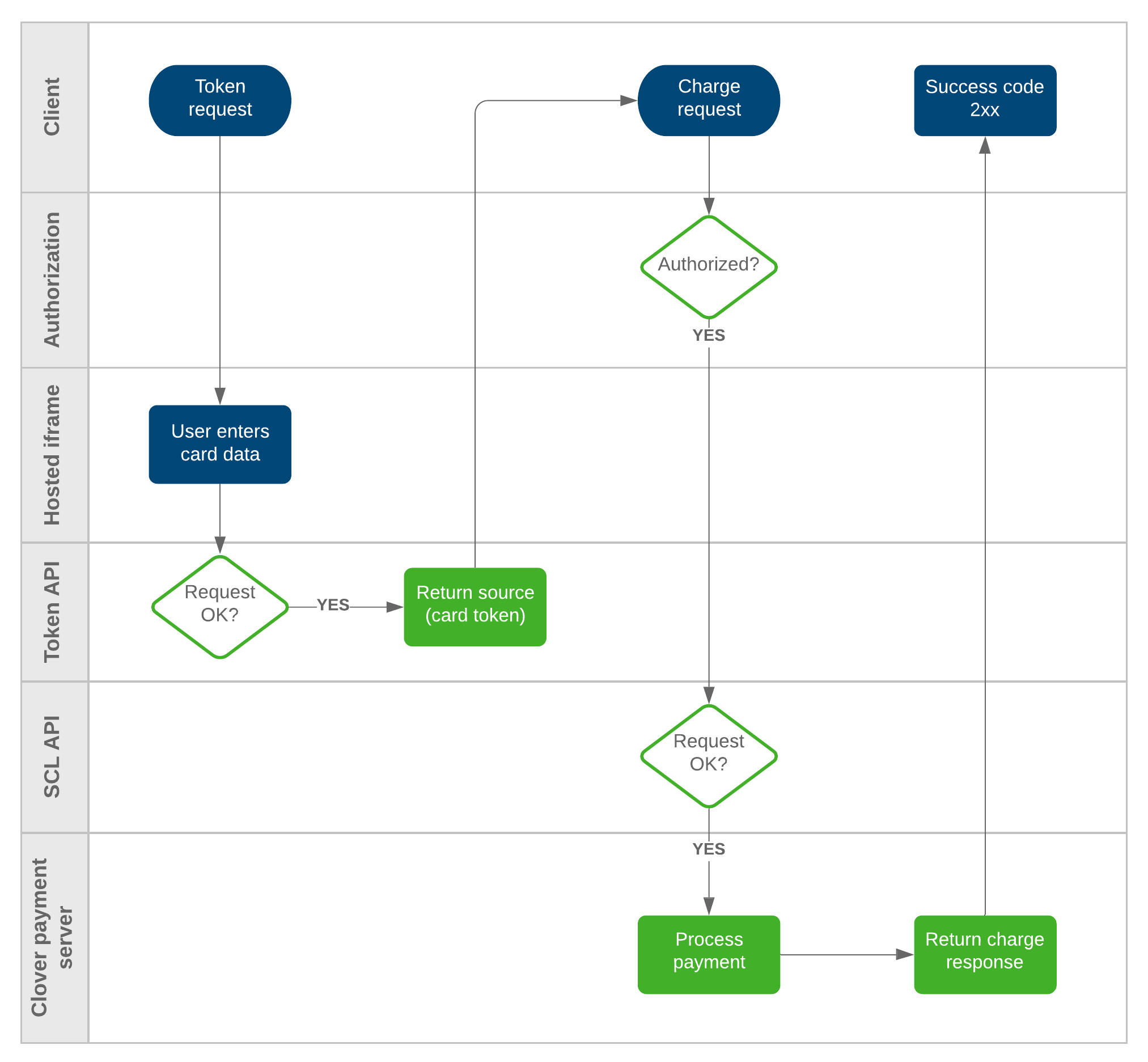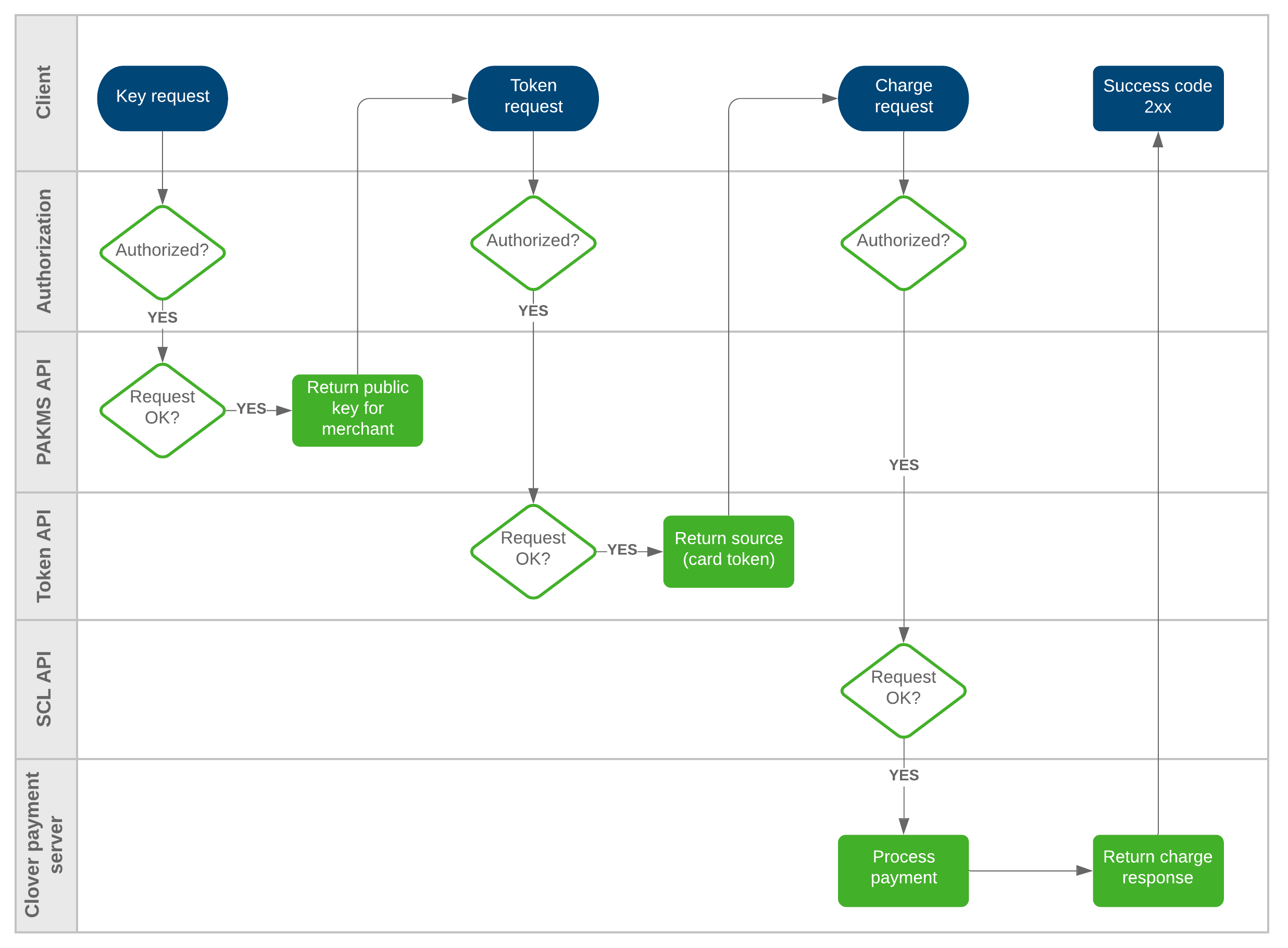Ecommerce integration and payment flows—Use cases
Clover offers different types of ecommerce integrations to cater to various business needs. Your apps can integrate with Clover Ecommerce services in different ways, depending on the needs of the app and merchants who use it. See Clover Ecommerce integration types.
Payment flows and Ecommerce integration use cases
iframe and API integration
PCI burden on developers & merchants:** LOW
The iframe tokenizer lets customers provide card data securely to the Clover servers. A source, which is an encrypted card token, is provided to your app after the card is encrypted and tokenized for use with the Clover payment system. This gives your app the benefit of reduced PCI compliance burden, as well as speeding up the integration and coding process by using a pre-built component. Clover keeps the tokenizer up to date with any future API changes, so your app requires less maintenance.
Use case
Most ecommerce merchants require an app built with this type of integration. It provides the greatest business benefit and the lowest security risk for card-not-present payments through a third-party Clover app. For instance, a Clover merchant running a small retail store wants to set up an online store to expand their customer base. You can quickly build the payment aspect of the online store with an iframe and API integration.

iframe and API request flow
Request flow ( iframe and API)
The fields in this example request are the minimum required for each endpoint. See the API Reference for complete information.
To charge a customer's card using the iframe and API, your app completes the following flow:
- Direct the customer to the iframe based on your app's user flow.
- Let the customer enter and submit their card information. The Clover server returns the tokenized card as a
source. - Send a POST request to the
v1/chargesendpoint to create a charge. - Create a charge request with the tokenized card information as
sourceand enter anamountin cents. The card is charged for the specifiedamount.
API-only integration
Use Clover Ecommerce APIs for custom integrations tailored to your specific requirements. Integrate with additional services for apps requiring complete control over the payment flow.
PCI burden on developers & merchants:** HIGH
For an API-only integration, you must use the PAKMS and token APIs in addition to the Ecommerce API, which provides access to charges and customer data. These APIs provide operations for your app to retrieve an encryption key and use that key to encrypt and tokenize card data.

API only request flow
Request flow (API only)
The fields in this example request are the minimum required for each endpoint. You need a Public Access Key Management Service (PAKMS) key that is unique for each merchant to complete the OAuth flow that lets you use the Clover Ecommerce API. The PAKMS key does not expire. You need to send a request to the PAKMS endpoint only once for each merchant when they first install and configure your app. Your app should store the returned PAKMS key for use in each of that merchant's subsequent charge requests. See the Ecommerce - PAKMS Service API reference for more information.
The entire flow to tokenize a card and create a charge is available in the Ecommerce API: Accept payments flow. Here is a high-level overview of what our app needs to complete the flow to charge a customer's card using only the Ecommerce API:
- Send an API
access tokenrequest containing themerchantIdand Clover App ID, also known as theclient_id. - Send an
apiAccessKeyrequest to the PAKMS key endpointGET /pakms/apikeyusing theaccess_token. - Set the
authorization: Beareras your OAuth-generatedaccess_token. See Authenticate with OAuth.
curl --request GET \
--url 'https://scl-sandbox.dev.clover.com/pakms/apikey' \
--header 'accept: application/json' \
--header 'authorization: Bearer {auth_token}'
The server returns an apiAccessKey.
- Create a card token request with a
cardobject and its required fields:number,exp_month,exp_year,cvv, andbrand. - In the
apikeyheader, enter theapiAccessKeyand send the request to the token endpoint:POST /v1/tokens.
curl --request POST \
--url 'https://token-sandbox.dev.clover.com/v1/tokens' \
--header 'accept: application/json' \
--header 'apikey: {apiAccesssKey}' \
--header 'content-type: application/json' \
--data '{
"card": {
"number": "6011361000006668",
"exp_month": "12",
"exp_year": "2031",
"cvv": "123",
"brand": "DISCOVER"
}
}'
The Clover server returns the tokenized card as a source. All source tokens are alphanumeric and begin with clv_.
- Create a charge
POST /v1/chargesrequest with the Clover token as thesourceand anamountin cents. The card is charged for the specifiedamount.
Related topics
- Ecommerce integration types.
- Create a card token tutorial for more information about encrypting card data and then tokenizing the encrypted data.
- Create a card token endpoint in the Ecommerce API to create a single-use token to make a payment.
Updated 8 months ago
